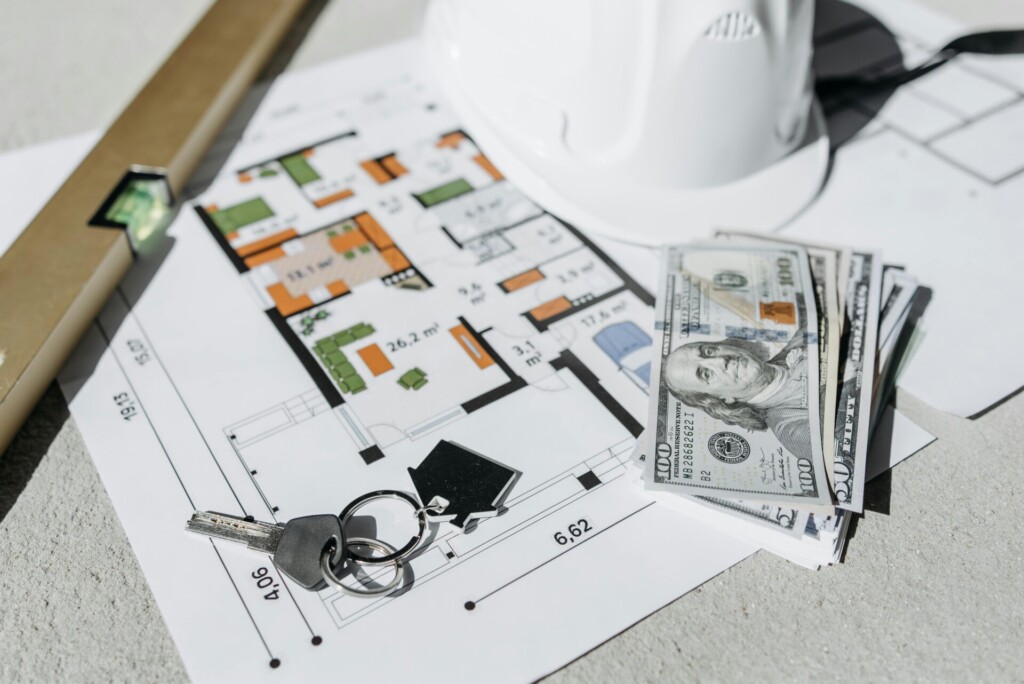Ground-up construction transforms an empty lot into a fully operational building through a carefully orchestrated series of phases. Unlike renovation projects that work with existing structures, this approach begins with raw land and builds everything from scratch.
The ground up construction process encompasses six core phases that property owners and developers can expect. Each phase builds on the previous one, creating a complete structure that meets modern building codes and delivers the design flexibility that only new construction can provide.
What Happens During Pre-Planning, Design, And Permitting?

Pre-construction establishes the project’s foundation by aligning stakeholders around scope, budget, and schedule. We coordinate multiple technical assessments during this phase, including land surveys that map property boundaries and identify potential conflicts. Environmental checks reveal soil conditions, drainage patterns, and any contamination issues that could impact construction methods or costs.
Zoning reviews verify that the proposed structure complies with local land use regulations. These assessments often uncover restrictions on building height, setbacks, or permitted uses that shape our design approach. We work with architects and engineers to develop schematic designs that balance client vision with regulatory requirements.
Design Development And Code Compliance
Architectural drawings evolve from conceptual sketches to detailed plans during this phase. Our design team creates layouts that optimize space usage while meeting accessibility standards and building codes. Engineering layouts for structural, mechanical, electrical, and plumbing systems ensure all components work together efficiently.
Code compliance reviews happen early to avoid costly redesigns later. We verify that proposed systems meet local building codes, fire safety requirements, and energy efficiency standards. This proactive approach prevents delays during the permit review process.
Project Planning And Team Assembly
We establish detailed timelines that account for design completion, permit processing, and construction phases. These schedules factor in seasonal considerations, material lead times, and inspection requirements. Subcontractor selection begins during pre-construction, allowing us to secure reliable trades and lock in pricing before construction starts.
Construction financing coordination involves working with lenders to provide detailed project documentation. Banks require comprehensive budgets, schedules, and architectural plans before approving construction loans. We prepare draw schedules that align funding releases with construction milestones.
Permit Applications And Regulatory Approvals
Building permits cover multiple scopes including structural, electrical, plumbing, and mechanical systems. Each permit requires specific documentation and may trigger additional requirements based on project complexity. We submit applications early in the design process to allow adequate processing time.
Regulatory approvals from planning departments, environmental agencies, and utility companies often run parallel to permit applications. Obtaining these approvals early prevents project delays and allows construction to proceed on schedule. Some permits require inspections at specific construction phases, which we coordinate with our building schedule to maintain project momentum.
What Site Preparation And Foundation Work Set The Project Up For Success?
Site preparation creates the essential groundwork that determines construction quality and timeline. We begin by clearing vegetation, debris, and any existing structures that interfere with the building footprint. This phase requires careful coordination with environmental regulations and proper disposal methods for organic materials.
Accurate grading establishes proper elevation and drainage patterns across the site. Professional grading uses GPS-guided equipment to meet exact specifications and prevent water accumulation near foundation areas. We create temporary access roads and staging areas for equipment and materials, ensuring efficient workflow throughout the project.
Soil Testing And Foundation Design
Comprehensive soil testing reveals load-bearing capacity, moisture levels, and soil composition before excavation begins. These geotechnical reports guide foundation type selection and inform any soil stabilization requirements. Clay soils may need different approaches than sandy or rocky conditions.
Testing identifies the depth to stable bearing soil and groundwater levels that affect foundation design. If unsuitable soil extends too deep, we remove and replace it with engineered crushed rock to provide adequate support. This early assessment prevents costly surprises during foundation work.
Temporary Structures And Utility Coordination
We establish temporary facilities including construction entrances, equipment storage, and worker facilities before major excavation begins. Proper erosion control measures protect surrounding properties from sediment runoff during site work.
Underground utility coordination prevents damage to existing gas, water, electrical, and communication lines. We contact utility companies for location services and plan new service routing to the building. Temporary utility connections support construction activities while permanent systems await final installation.
Foundation Excavation And Installation
Excavation removes soil to the required depth for footings, which must extend below the frost line to prevent seasonal movement. We maintain proper slopes and safety measures during excavation to protect workers and adjacent properties.
Foundation walls rise from footings to support the building structure above grade. Concrete placement requires careful timing and proper curing conditions for maximum strength. We install perimeter drainage systems around foundations to direct water away from the structure and prevent hydrostatic pressure buildup.
This systematic approach to site preparation and foundation work establishes the stable platform necessary for efficient construction phases ahead. Attention to soil conditions, drainage management, and utility coordination prevents delays and ensures structural integrity from the ground up.
How Is The Main Construction Phase Sequenced And Managed?

Once site preparation and foundation work establish the project’s structural groundwork, we move into the main construction phase where the building takes shape. This phase requires careful sequencing to ensure trades work efficiently without conflicts or delays.
Construction Sequence And Phase Management
We follow a logical construction sequence that builds from the structure outward. Framing comes first, creating the building’s skeleton with structural elements including load-bearing walls, floor systems, and roof structures. This structural work must pass inspections before we can proceed to the next phase.
Roofing and exterior work follow framing completion. We install the roof system, exterior walls, windows, and doors to create a weatherproof envelope. This sequence protects interior work from weather exposure and allows multiple trades to work simultaneously on different building areas.
Interior systems installation begins once the building envelope is secure. We coordinate plumbing, HVAC, and electrical trades to install their rough-in work before walls are closed up. MEP coordination prevents conflicts between systems and ensures proper clearances for equipment access.
Project Management And Trade Coordination
We assign a dedicated project manager to oversee schedule coordination, budget tracking, and material logistics throughout this phase. The project manager maintains daily communication with subcontractors, monitors progress against the baseline schedule, and addresses any issues that could impact the timeline.
Our general contractor coordinates all trades on site, managing workflow to prevent scheduling conflicts. We establish clear protocols for safety compliance, material delivery schedules, and quality checkpoints. Daily progress meetings keep all parties aligned on immediate priorities and upcoming work.
Material logistics become critical during this phase as multiple trades require deliveries. We coordinate delivery schedules to prevent site congestion and ensure materials are available when needed without excessive on-site storage requirements.
Quality Control And Safety Inspections
We implement systematic quality control processes throughout construction phases. Regular inspections verify that framing meets structural specifications, MEP systems follow approved layouts, and all work complies with building codes. These inspections occur at specific milestones before work is concealed.
Safety protocols remain paramount during this busy construction phase. We conduct routine safety inspections of scaffolding, fall protection systems, and fire safety measures. Construction phases with multiple trades working simultaneously require heightened coordination to maintain safe working conditions.
Quality control inspections focus on critical building systems including structural connections, waterproofing details, and life-safety systems. We document all inspections and maintain clear records for regulatory compliance and project closeout requirements.
What Risks Affect Schedule And Budget, And How Do You Manage Them?
Ground-up construction faces several predictable challenges that can impact project timelines and budgets. Permit delays rank among the most common issues, often extending schedules by weeks or months when approval processes slow down or documentation requires revisions. Supply chain disruptions affect material deliveries, with price fluctuations and availability constraints creating budget pressures throughout the project lifecycle.
Weather delays present another significant risk, particularly during critical phases like foundation work or roofing installation. Labor constraints compound these challenges, as skilled trade shortages can slow progress even when materials arrive on schedule. Unforeseen site conditions, such as unstable soil or underground utilities not shown on surveys, frequently emerge during excavation and require immediate attention.
Time management becomes particularly crucial for ground-up projects, which typically require longer construction periods than renovation work. We coordinate multiple trades across extended timelines, making schedule control essential for maintaining budget discipline. Each delay creates ripple effects that can impact subsequent phases and overall project completion.
Risk Mitigation Through Strategic Planning
We implement comprehensive pre-planning to identify potential issues before they affect construction schedules. This includes conducting thorough site investigations, reviewing utility locations, and coordinating with local authorities early in the design phase. Clear communication protocols ensure all stakeholders understand project requirements and potential challenges.
Contingency funds represent a critical component of effective risk management. We typically allocate 10-15% of the construction budget for unexpected costs, with the exact percentage varying based on project complexity and site conditions. These reserves cover change orders, unforeseen conditions, and material price increases without derailing the overall budget.
Progress monitoring systems track daily activities, material deliveries, and milestone completion. We use real-time reporting to identify potential delays early, allowing for corrective action before issues compound. Regular site meetings keep all trades informed about schedule adjustments and coordinate activities to maintain project momentum.
Financial Controls And Documentation
Construction financing requires detailed documentation throughout the project lifecycle. Lenders typically mandate comprehensive budgets, detailed schedules, and regular progress reports before releasing funds. We maintain thorough records of all expenditures, change orders, and schedule adjustments to support draw requests and maintain financial transparency.
Monitoring draw use during construction helps prevent budget overruns and ensures adequate cash flow for project completion. We track spending against budgeted amounts for each construction phase, providing early warning when costs begin exceeding projections. This allows us to implement corrective measures before financial issues become critical.
Documentation extends beyond financial records to include quality control measures, safety protocols, and regulatory compliance. Proper documentation supports insurance claims, warranty issues, and potential disputes while demonstrating adherence to building codes and construction standards. These records also facilitate proactive risk management strategies that construction firms increasingly adopt to minimize project disruptions.
Building new construction projects also creates opportunities to improve energy efficiency and ensure full code compliance with current standards. Modern building systems and materials often provide better performance than renovation projects constrained by existing infrastructure. This approach can reduce long-term operating costs and enhance building value, offsetting some initial construction risks through improved project outcomes.
Closeout, Occupancy, And Next Steps
Project closeout transforms months of construction work into a fully functional, code-compliant building ready for occupancy. This final phase requires systematic completion of remaining tasks, comprehensive documentation, and careful coordination between all project stakeholders.
System Testing And Commissioning
We conduct thorough testing of all building systems before final inspections begin. HVAC systems undergo complete commissioning to verify proper operation, energy efficiency, and compliance with design specifications. Electrical systems receive comprehensive testing including arc flash studies and coordination with utility providers.
Fire safety systems require detailed testing and documentation. We verify sprinkler system functionality, test fire alarm components, and ensure emergency lighting operates correctly. Each system must meet local fire codes and pass inspection by certified technicians.
Plumbing systems undergo pressure testing and flow verification. Water quality testing confirms potability standards, while backflow prevention devices receive proper certification. These steps ensure building systems function safely and reliably from day one.
Punch List Completion And Final Inspections
We develop comprehensive punch lists through detailed walkthroughs with owners and design teams. These lists identify any remaining deficiencies, incomplete work, or items requiring correction before final acceptance. Punch list items typically include minor repairs, touch-up work, and system adjustments that don’t affect overall building functionality.
Final inspections by local building authorities represent the critical checkpoint before occupancy approval. We coordinate these inspections carefully, ensuring all required permits are closed and all work meets current building codes. Electrical, plumbing, mechanical, and fire safety inspections must all pass before authorities will issue occupancy certificates.
Documentation plays a crucial role during inspections. We provide inspectors with complete records of material certifications, system testing results, and compliance verifications. This thorough preparation helps streamline the inspection process and reduces delays.
Certificate Of Occupancy And Utility Activation
Obtaining the certificate of occupancy marks the formal transition from construction to operational status. This document certifies that the building complies with all applicable codes, is safe for intended use, and ready for occupancy. The process requires coordination between contractors, local authorities, and utility companies.
Utility activation involves transferring service from temporary construction accounts to permanent building systems. We coordinate with electric, gas, water, and telecommunications providers to ensure seamless transitions. Permanent utility connections must be tested and verified operational before occupancy certificates are issued.
Some municipalities offer temporary certificates of occupancy when minor non-safety issues remain unresolved. These allow partial occupancy while final details are completed, helping owners begin operations without waiting for every cosmetic item to be finished.
Documentation Handover And Training
We compile comprehensive handover packages containing all documentation needed for ongoing building operations. These packages include as-built drawings reflecting actual installed conditions, operation and maintenance manuals for all equipment, and warranty information for building systems and components.
Training sessions help building operators understand new systems and equipment. We schedule these sessions during the closeout phase, ensuring facility managers receive proper instruction on HVAC controls, security systems, and specialized equipment. This training helps prevent operational issues and ensures warranty compliance.
Digital documentation increasingly replaces traditional paper binders. We organize files with clear naming conventions and searchable formats that facility managers can access easily when needed. This approach improves long-term usability and reduces storage requirements.
Ongoing Maintenance Planning And Future Considerations

We help owners develop maintenance schedules that protect their investment and maintain building performance over time. These plans identify critical maintenance intervals for major systems, recommended service providers, and anticipated replacement schedules for equipment with limited service lives.
Energy efficiency monitoring becomes important after occupancy begins. We recommend tracking utility usage patterns and system performance to identify optimization opportunities. Many building systems can be fine-tuned after occupancy to improve efficiency and reduce operating costs.
Future upgrade planning considers evolving technology and changing operational needs. We discuss potential expansion capabilities, infrastructure provisions for future improvements, and recommended intervals for major system updates. This forward-thinking approach helps owners make informed decisions about their facilities.
Warranty management requires ongoing attention throughout the first year of operation. We provide detailed warranty tracking information and help owners understand their rights and responsibilities under various warranty agreements. Proper warranty management can save significant costs when issues arise.
Ready to start your next ground-up construction project? Contact EB3 Construction today to discuss how we can bring your vision to life with our comprehensive approach to commercial construction.




